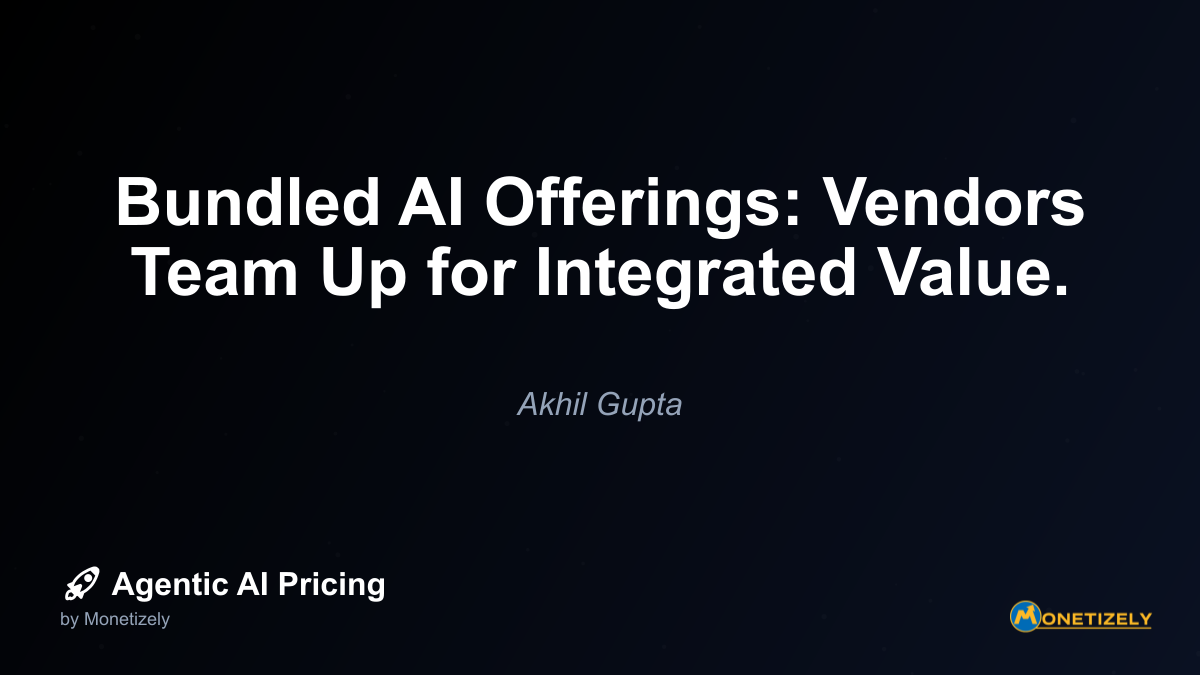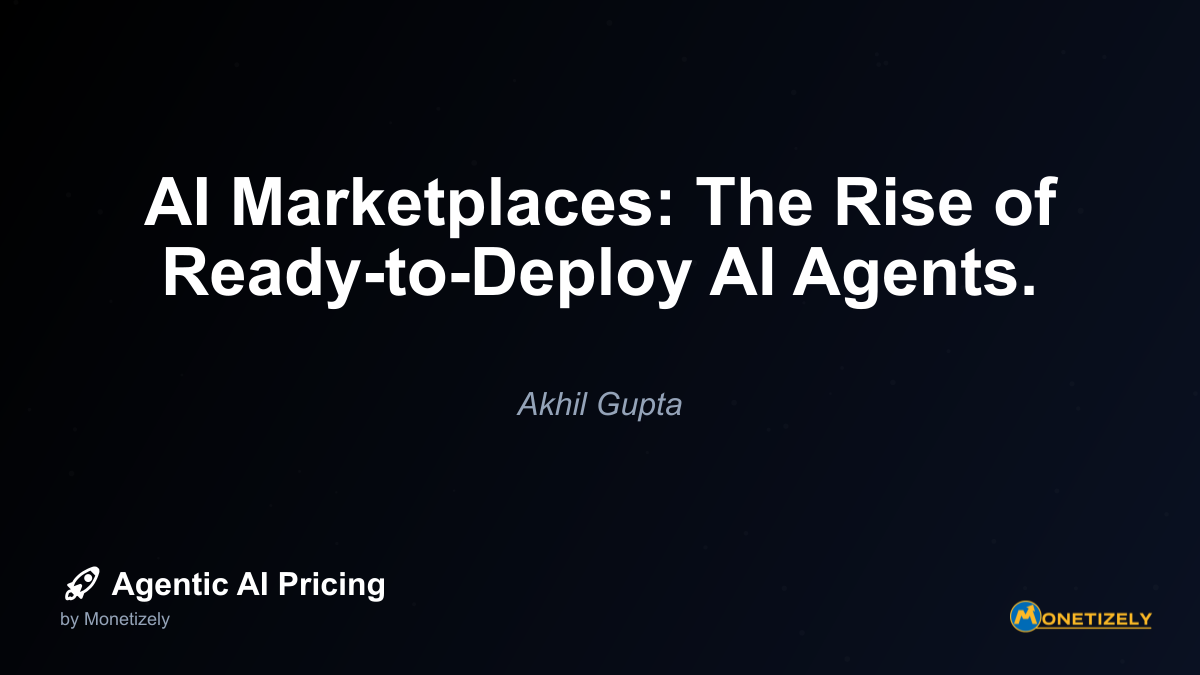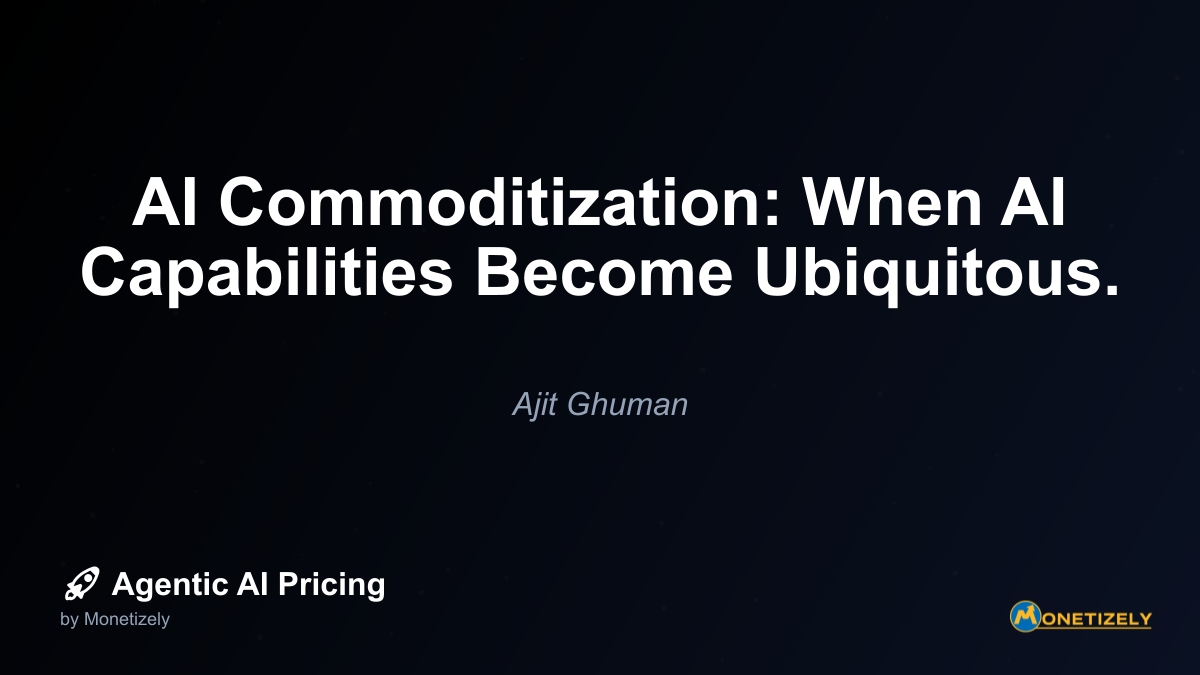· Akhil Gupta · Emerging Trends · 7 min read
Bundled AI Offerings: Vendors Team Up for Integrated Value.
AI and SaaS Pricing Masterclass
Learn the art of strategic pricing directly from industry experts. Our comprehensive course provides frameworks and methodologies for optimizing your pricing strategy in the evolving AI landscape. Earn a professional certification that can be imported directly to your LinkedIn profile.

Key elements of effective unified customer experience include:
Single contract: Customers should ideally sign a single agreement covering all bundled components, rather than separate contracts with each provider.
Unified billing: A consolidated invoice presenting all components as a cohesive solution simplifies the customer’s procurement and accounting processes. As explored in integration platforms for AI agent billing, the technical infrastructure supporting these unified billing systems is critical for partnership success.
Integrated support: Customers should have a clear understanding of how support works across the bundled offering, preferably with a single point of contact for all components.
Consistent user interface: The most successful bundles present a seamless user experience where different components feel like parts of a unified solution rather than separate products cobbled together.
Coordinated roadmaps: Partners should align their development priorities to ensure the bundled solution evolves cohesively rather than components developing in conflicting directions.
Value Proposition Communication
Successfully marketing bundled AI offerings requires clear communication of the integrated value proposition. Customers need to understand not just the capabilities of individual components, but the unique benefits that arise from their integration.
Effective value proposition communication strategies include:
Solution-oriented messaging: Focus on the end-to-end customer problems solved rather than technical features of individual components.
Integration benefits: Highlight the specific advantages gained through integration, such as streamlined workflows, reduced data transfer needs, or enhanced analytics capabilities.
ROI calculations: Provide concrete examples of return on investment that account for both the direct cost savings from bundle pricing and the operational efficiencies gained through integration.
Case studies: Showcase real-world examples where the integrated solution delivered outcomes that would have been difficult to achieve with separate components.
Comparative analysis: Offer transparent comparisons between the bundled offering and alternative approaches, including building in-house or purchasing components separately.
Partnership Governance and Evolution
The long-term success of bundled AI offerings depends on effective partnership governance structures that can adapt to changing market conditions and evolving customer needs.
Critical governance considerations include:
Clear decision rights: Establishing which partner has authority over different aspects of the bundled offering, from pricing changes to feature prioritization.
Performance metrics: Defining shared key performance indicators that measure the success of the partnership beyond simple revenue figures.
Conflict resolution mechanisms: Creating processes to address inevitable disagreements about strategy, resource allocation, or customer support responsibilities.
Renewal and renegotiation terms: Setting expectations for how and when the partnership terms will be reviewed and potentially adjusted.
Exit strategies: Defining how the partnership could be unwound if necessary, with particular attention to customer impact and data transition.
Challenges in Bundled AI Offerings
While the strategic benefits of bundled AI offerings are compelling, partnerships face several common challenges that must be addressed proactively:
Technical Integration Complexity
Truly integrated solutions require deep technical collaboration beyond simple API connections. Partners must invest in robust integration architecture that addresses:
- Data synchronization and consistency
- Authentication and security alignment
- Performance optimization across components
- Coordinated update and maintenance processes
- Compatibility testing and quality assurance
Brand and Identity Considerations
Bundled offerings raise questions about brand prominence and customer perception. Partners must navigate:
- Which brand takes precedence in marketing materials
- How individual company identities are represented within the integrated solution
- Customer attribution and ownership in analytics
- Balancing co-marketing efforts with individual brand building
Pricing Power Dynamics
Determining fair pricing for bundled offerings involves complex negotiations around:
- Relative value contribution of different components
- Price sensitivity variations across customer segments
- Discount allocation between partners
- Handling of premium features or tiered pricing models
Competitive Positioning Challenges
Partners must carefully consider how bundling affects their broader competitive strategy:
- Potential cannibalization of standalone offerings
- Exclusivity considerations with other partners
- Competitive response from rivals who may form counter-partnerships
- Maintaining differentiation within the partnership ecosystem
Future Trends in Bundled AI Offerings
Looking ahead, several emerging trends will likely shape the evolution of bundled AI partnerships:
Ecosystem-Based Bundling
Rather than simple one-to-one partnerships, we’re seeing the emergence of broader AI ecosystems where multiple specialized providers collaborate around core platforms. These arrangements may involve tiered partnership levels, marketplace models, and complex revenue-sharing frameworks that accommodate many participants.
Vertical-Specific Solution Bundles
As AI adoption matures, bundled offerings are becoming increasingly tailored to specific industry verticals. These specialized bundles combine horizontal AI capabilities with deep domain expertise, pre-configured workflows, and industry-specific data models to deliver immediate value in particular sectors.
Open Standards for AI Integration
The development of open standards for AI component interoperability could significantly reduce the technical friction in creating bundled offerings. Standards around data exchange, model interoperability, and security frameworks would allow for more flexible and dynamic partnerships.
Dynamic Bundle Composition
Advanced bundling approaches are moving toward more dynamic models where customers can select from a menu of compatible components, potentially with automated price adjustments based on their selections. This approach balances the simplicity of bundled offerings with the customization benefits of à la carte selection.
AI-Powered Bundle Optimization
Ironically, AI itself may play a growing role in optimizing bundled offerings by analyzing usage patterns, identifying complementary components, and dynamically adjusting bundle composition and pricing to maximize customer value and partnership economics.
Implementing Successful Bundled AI Strategies
For organizations considering bundled AI strategies, several key recommendations emerge from successful implementations:
For Platform Providers
Develop a partnership framework: Create clear criteria for potential partners, including technical requirements, business model alignment, and value proposition complementarity.
Invest in integration infrastructure: Build robust APIs, documentation, and developer resources that make it easy for partners to integrate deeply with your platform.
Establish fair economics: Design revenue-sharing models that appropriately reward partners while maintaining your platform economics.
Create partnership tiers: Consider different levels of partnership commitment, from simple integrations to deeply bundled offerings with joint go-to-market activities.
For Specialized AI Providers
Identify strategic platform partners: Focus on platforms that reach your target customers and offer complementary rather than competing capabilities.
Demonstrate integration value: Clearly articulate the unique benefits that arise from integrating your specialized capability with the broader platform.
Balance exclusivity and reach: Carefully consider the tradeoffs between deeper integration with fewer platforms versus broader availability across many platforms.
Build partnership competencies: Develop the technical and business capabilities needed to succeed in partnership-driven models, which may differ from direct sales approaches.
For Customers Evaluating Bundled Offerings
Assess integration depth: Look beyond marketing claims to understand how deeply the components are actually integrated and what specific benefits this integration provides.
Evaluate partnership stability: Consider the strategic alignment between the partners and the likelihood that the bundled offering will be supported long-term.
Compare bundle economics: Calculate the total cost of ownership for the bundled solution versus acquiring and integrating components separately.
Plan for contingencies: Understand what would happen if the partnership dissolved or if one component needed to be replaced with an alternative.
Conclusion
Bundled AI offerings represent a strategic evolution in how AI capabilities are delivered to customers, moving from isolated point solutions to integrated value propositions. This collaborative approach allows vendors to combine complementary strengths, accelerate time-to-market, and deliver more comprehensive solutions than would be possible individually.
Successful implementation of bundled AI strategies requires thoughtful approaches to pricing, revenue sharing, customer experience, and partnership governance. Organizations must balance the benefits of integration with the complexities of multi-vendor collaboration, all while maintaining clear value propositions for customers.
As the AI ecosystem continues to mature, we can expect bundled offerings to become increasingly sophisticated, with deeper technical integration, more flexible composition models, and more tailored industry solutions. Organizations that master the art of strategic partnership and bundled value creation will be well-positioned to thrive in this collaborative future of AI solution delivery.
For businesses navigating the complex landscape of AI partnerships and bundling strategies, staying informed about emerging best practices and evolving models will be essential. The most successful organizations will be those that view bundling not merely as a pricing tactic but as a fundamental strategy for delivering comprehensive value in an increasingly interconnected AI ecosystem.
Co-Founder & COO
Akhil is an Engineering leader with over 16+ years of experience in building, managing and scaling web-scale, high throughput enterprise applications and teams. He has worked with and led technology teams at FabAlley, BuildSupply and Healthians. He is a graduate from Delhi College of Engineering and UC Berkeley certified CTO.
Pricing Strategy Audit
Let our experts analyze your current pricing strategy and identify opportunities for improvement. Our data-driven assessment will help you unlock untapped revenue potential and optimize your AI pricing approach.




